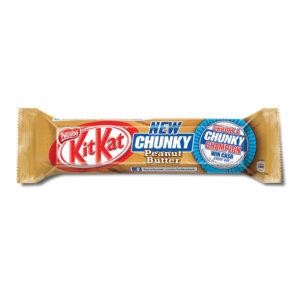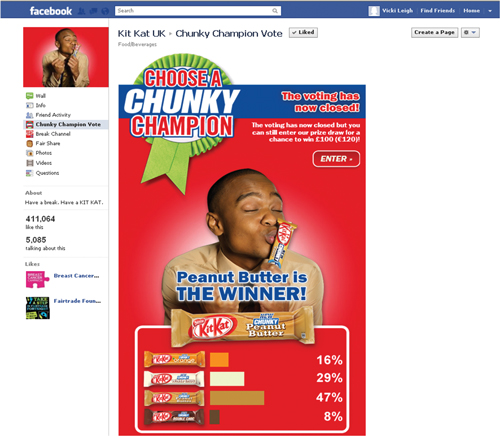Rejuvenating a Brand Through Social Media
When Nestlé UK let customers vote via social media for their favorite new flavor of the company’s Kit Kat Chunky chocolate bar, customer engagement increased — and Nestlé developed successful new offerings.
Today’s managers understand the potential of social media engagement for generating business value. With each click, comment, “like” or post, consumers leave vital pieces of information — in effect, virtual footprints — that can be aggregated to generate new insights for brand management and engagement. However, companies often lack the right tools to guide them in this process. Without a framework with which to convert the mass of user-generated content into knowledge, the business value of social media stays hidden in plain sight.
One exception is Nestlé, which has developed a strong capacity to manage its social space and extract useful insights from the voluminous data created via social media. To gain insights into how Nestlé has learned to capture this value, for a year we followed Nestlé UK’s campaign to rejuvenate its Kit Kat chocolate bar brand among 18- to 24-year-olds. By successfully leveraging social media for the Kit Kat brand, Nestlé UK was able to induce positive word of mouth through the development of consumers who serve as brand advocates; increase sales and innovativeness; and generate a higher return on investment.
From these observations and other insights from our research, which also involved an in-depth study of social media use by another Nestlé UK brand, we have derived a four-step framework that we believe will enable companies in any sector to extract valuable information from the vast amount of data that social media engenders.
A Four-Step Framework for Social Media Utilization
After an extensive series of interviews and detailed observations of Facebook fan pages, we found that Nestlé UK followed a four-step utilization framework, which we call the SELI (Scan, Engage, Learn and Internalize) framework, to strengthen its Kit Kat Chunky brand by nurturing a social network. The sequential steps of this framework are documented in the following:
Before you begin: Specify the goal or objective. Before applying the framework and engaging with consumers on social networks, senior managers should specify a goal or business objective underlying the conversation with the consumer. In particular, managers need to direct the channel toward achieving a specific marketing or brand goal, such as increasing brand awareness, brand loyalty and engagement, intelligence gathering, or new product development.
In this case, Kit Kat brand managers wanted to find ways to leverage social media as a means to build enthusiasm among 18- to 24-year-olds for Kit Kat, a leading chocolate bar brand for Nestlé UK. Given the rapid proliferation and use of social networking tools among 18- to 24- year-olds, as well as the sheer volume of user information and content available about them online, social media was an obvious channel for brand development — especially as the Kit Kat brand already had its own dedicated Facebook fan page and an active user audience of more than 200,000 users at the time.
By using an integrated polling tool that allowed users to freely comment on, “like” and vote for different flavors, Kit Kat managers built customer interest in the brand.
Step 1: Scan and map the social space around the brand and its competitors.
Researchers have known for the better part of a decade that insights embedded in social networks are an important source of brand-related business intelligence. Managers should actively monitor and track user-generated content — the conversations that are happening on both their own and competitors’ social media pages — to help identify emerging trends. To extract information about the Kit Kat brand, Nestlé UK managers used advanced IT tools to analyze, text mine and data mine user-generated content to find clues about how they might deepen attachment to the brand. One such insight: Flavors were often a major topic of conversation among Kit Kat fans posting on the Kit Kat Facebook page. As one manager pointed out:
It gave our fans a forum to discuss flavors, whether that be Kit Kat flavors in other markets like Japan, where we have green tea and Swiss cheese … The product is why they are there; they want to talk about the brand. This was a perfect lead for us to use our Facebook audience to drive commercial success of [the] Chunky brand by allowing them to cocreate on flavors that would become a permanent [brand] fixture.
Step 2: Engage with consumers on social networks to increase external knowledge inflows.
Next, companies should engage and create a dialogue with consumers based on the insights developed by scanning the social media space. Today’s social networking sites support multimodal means of communication that can include text, pictures and audiovisual tools, as well as the integration of additional platforms — for example, embedding YouTube videos on Facebook. By using these tools, managers increase access and outreach to engage a larger audience of consumers in a way that may help further develop and refine the market insights the company gains.
In 2012, for this second step, Nestlé UK started a social media campaign — “Choose a Chunky Champion” — to capitalize on user interest in Kit Kat flavors and to engage users in cocreation by voting on new flavors. The campaign urged users to vote for their preferred new flavor from among several choices that, in turn, were based on fan page user comments. Fans chose their favorite among white chocolate, double chocolate, orange and peanut butter and were promised that the winner would become a permanent new flavor. Votes were taken over a 40-day period.
By using an integrated polling tool that allowed users to freely comment on, “like” and vote for different flavors, Kit Kat managers built customer interest in the brand and stimulated much more content than the brand had generated before. By using and posting content more strategically, Nestlé managers boosted interest in the brand and gained vital information for brand development and other strategic goals. Beyond stimulating conversations about the brand, Nestlé used this process to gauge consumer reactions as well as interactions, opinions and behaviors in relation to the content consumers had posted.
Step 3: Learn from engagement with consumers.
Once the company is in an active process of creating a strategic dialogue with consumers on social media, the next step is to piece together the knowledge acquired to ensure learning. Learning occurs through a conversion process, in which the company uses polls, conversation threads and open-ended questions to make user-generated content more digestible.
Nestlé UK outsourced this capability through an active partnership with Facebook as well as with digital agencies that helped the company handle the volume of data and user-generated content flowing from Kit Kat’s Facebook fan page. As the communication manager stated:
We work alongside Facebook and digital agencies to help us use the data and make the most of it. They help us to realize the capability on there [social media], keeping us up to date with how our demographics are changing and the trends they see from our social space.
Powerful analytics and internal capabilities are required to derive meaning from social media interactions. In our research, we found that lack of an internal capability to deal with the large volumes of data generated on social networks can hinder a business’s ability to gain insights from its end-user communities. The success of Nestlé UK’s partnership with Facebook suggests that intermediaries or consultancies can play an important role in translating user-generated content into explicit knowledge that the company can learn from to realize the benefits of social media engagement. This process helped Nestlé UK managers uncover more detail about user impressions of the brand, new product opportunities and potential opinion leaders whose enthusiasm might be nurtured to create word-of-mouth effects and increase awareness among the brand’s target audience.
Step 4: Internalize and apply knowledge gained from social networks.
Next, managers must communicate the lessons and knowledge learned from social network interactions throughout the whole organization or division to ensure that the new knowledge, best practices and solutions gained from interacting with the social networks are put to work.
In this case, by using social media, Kit Kat managers were able to conduct market research on a larger scale than ever before in the brand’s history. Specifically, managers reflected on the way social media enabled them to conduct large-scale market research at low cost. By using an integrated polling tool on Facebook that aggregated user votes, the winning flavor (peanut butter) was automatically selected after the 40-day balloting period without the need for any post-processing. Kit Kat marketing managers had successfully engaged consumers in cocreation to generate and produce new brand alternatives that were better aligned with the needs of their target audience, which at the same time facilitated brand rejuvenation.
After the first campaign was a huge success, Kit Kat managers decided to repeat the campaign the following year. In 2013, they launched another “Choose a Chunky Champion” campaign — this time, with mint, chocolate fudge, coconut and hazelnut on the ballot.
The implementation of social media for brand development had a positive impact for Nestlé UK. By engaging consumers in collaborative efforts for a new flavor, Kit Kat increased market penetration by 8% among 18- to 24-year-olds, a key candy-eating demographic. Furthermore, the social network interactions led to the development of new brand advocates. As the assistant brand manager pointed out, the campaign resulted in hundreds of thousands of consumers communicating about the brand online:
That’s massive, and that’s people choosing actively to talk about us. And it’s us creating excitement for them and giving them a space and a forum to express that. For me, that is the key thing.
Consumers who serve as brand advocates in their social networks tend to have strong peer influence and word-of-mouth effects within the social community. Advocates involved in the 2012 “Choose a Chunky Champion” campaign helped increased brand engagement, with the Facebook fan page doubling from 200,000 to more than 400,000 users. Following market introduction of the campaign winner, the new peanut butter-flavored Kit Kat Chunky was named 2012’s best new chocolate confectionary product by The Grocer magazine. As a result of the “Choose a Chunky Champion” social media campaign, brand equity, reach, engagement and market success all increased.
However, if Kit Kat’s success showcases the potential of social media, it also highlights why many companies’ social media efforts have failed to yield a significant return. Our research suggests that lack of an internal capability to handle “big data” can be a key stumbling block; Nestlé’s partnerships with Facebook and digital advertising agencies were a key component in the campaign’s success. Another crucial component had nothing to do with social media, per se, but with the comparative lack of corporate hierarchy within the Kit Kat social media team. We believe that hierarchical structures can act as a barrier that prevents external knowledge of consumers from reaching the business; flatter, less bureaucratic structures seem to be as important to social media success as sophisticated data analysis. Nestlé deployed a decentralized cross-functional team spearheaded by an internal social media “champion” so the team could more easily traverse internal functions and departments and avoid the structural barriers that often hamper learning in Nestlé, as at so many global companies. As the social media champion put it:
As I said before, our [Nestlé UK] size, internal processes and procedures stop us from being proactive. As such, we follow a decentralized approach to social media implementation across brands, which allows us to be more flexible.
Although we focused on one social media campaign for a candy brand, the four-step methodology we uncovered should be useful in a variety of marketing contexts. Social media offers marketers an unprecedented chance to know their customers better, but only if they approach it the way they would any other major marketing challenge — with a strategy, a spirit of inquiry and imagination.



Comments (3)
tarah.L careem
Doreen Khakusuma
deonchan